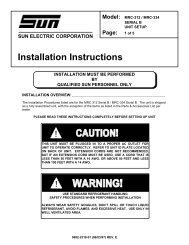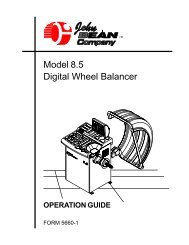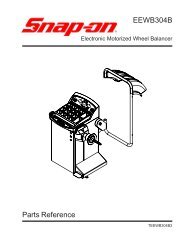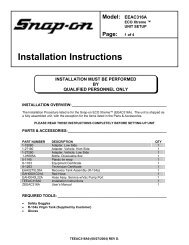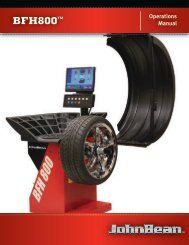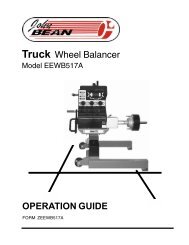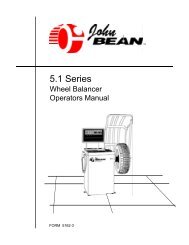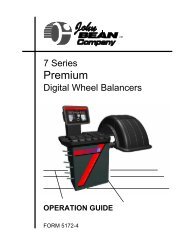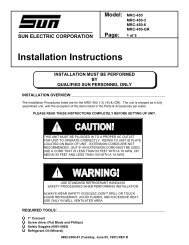700 Series Disk and Drum Lathe Operators Manual - Snap-on ...
700 Series Disk and Drum Lathe Operators Manual - Snap-on ...
700 Series Disk and Drum Lathe Operators Manual - Snap-on ...
You also want an ePaper? Increase the reach of your titles
YUMPU automatically turns print PDFs into web optimized ePapers that Google loves.
HOW TO MACHINE A DISC<br />
BRAKE ROTOR<br />
Model <str<strong>on</strong>g>700</str<strong>on</strong>g><br />
After the following instructi<strong>on</strong>s are read<br />
<str<strong>on</strong>g>and</str<strong>on</strong>g> understood, obtain a scrap rotor<br />
for practice. Select the proper adapters<br />
for mounting <strong>on</strong> spindle. Mounting<br />
is <strong>on</strong>e of the most important functi<strong>on</strong>s<br />
of the machining operati<strong>on</strong>, as it<br />
affects accuracy <str<strong>on</strong>g>and</str<strong>on</strong>g> finish.<br />
Practice setting cutters for machining<br />
rotors. Learn all the functi<strong>on</strong> thoroughly<br />
to insure proper operati<strong>on</strong>.<br />
Machining Limitati<strong>on</strong>s - Rotors<br />
Since 1971, rotors have the minimum<br />
thickness values cast into the outer<br />
surface.<br />
The proper procedure for determining<br />
whether to resurface rotors or discard<br />
them is listed below:<br />
A. Using a John Bean 90317 (90318<br />
- metric) micrometer or some other<br />
micrometer suitable for measuring the<br />
thickness of the rotor to be machined,<br />
check the rotor thickness at four points<br />
(90 degrees apart) about 1" from the<br />
outer diameter.<br />
B. If the thickness at any of the four<br />
points is less than the minimum established<br />
by car manufacturers as<br />
shown <strong>on</strong> the rotor or in the current<br />
John Bean Brake Specificati<strong>on</strong>s Book,<br />
replace the rotor.<br />
C. The rotor may be resurfaced if<br />
scored or it has a small amount of<br />
runout, provided it is within the minimum<br />
thickness requirement.<br />
D. After the rotor is machined, measure<br />
the thickness again, <str<strong>on</strong>g>and</str<strong>on</strong>g>, if it is<br />
not within the allowable minimum limits,<br />
discard it.<br />
NOTE: This check requires a measurement<br />
in <strong>on</strong>ly <strong>on</strong>e spot if both braking<br />
surfaces cleaned up 100%, because<br />
the turning operati<strong>on</strong> assures<br />
almost absolute parallelism.<br />
Mounting Brake Rotors<br />
1. Hub Type Rotors<br />
On a <str<strong>on</strong>g>700</str<strong>on</strong>g> lathe, proceed as follows:<br />
A. Clean excess grease from bearing<br />
races of rotor. Inspect bearing races<br />
for damage <str<strong>on</strong>g>and</str<strong>on</strong>g> replace if necessary.<br />
B. Select collets to fit in bearing<br />
races. Refer to current <str<strong>on</strong>g>Drum</str<strong>on</strong>g> <str<strong>on</strong>g>and</str<strong>on</strong>g><br />
Rotor Specs. book.<br />
C. Install collet for inner bearing race<br />
<strong>on</strong> arbor. See Figure 25. Then mount<br />
the rotor, collet for outer bearing race,<br />
<str<strong>on</strong>g>and</str<strong>on</strong>g> necessary spacers to fill arbor<br />
past mounting surface. Install arbor<br />
nut <str<strong>on</strong>g>and</str<strong>on</strong>g> tighten by h<str<strong>on</strong>g>and</str<strong>on</strong>g>. This will<br />
center the rotor <strong>on</strong> the collets. Using<br />
90578 Spanner Wrench, tighten arbor<br />
nut snugly. If rotor touches housing,<br />
place a spacer <strong>on</strong> arbor between<br />
inner collet <str<strong>on</strong>g>and</str<strong>on</strong>g> arbor shoulder.<br />
2. Mounting Hubless Rotors.<br />
A. Locate 90527 Hubless Rotor<br />
Adapter Set <str<strong>on</strong>g>and</str<strong>on</strong>g> proper c<strong>on</strong>e to fit<br />
rotor to be machined.<br />
B. Install <strong>on</strong>e face plate over arbor,<br />
then follow with a spring <str<strong>on</strong>g>and</str<strong>on</strong>g> centering<br />
c<strong>on</strong>e.<br />
C. Place rotor over arbor <str<strong>on</strong>g>and</str<strong>on</strong>g> centering<br />
c<strong>on</strong>e, then install sec<strong>on</strong>d face<br />
plate over arbor <str<strong>on</strong>g>and</str<strong>on</strong>g> up against rotor.<br />
D. Add necessary spacers to fill arbor<br />
past mounting surface. Install arbor<br />
nut <str<strong>on</strong>g>and</str<strong>on</strong>g> tighten by h<str<strong>on</strong>g>and</str<strong>on</strong>g>. This will<br />
center the rotor to the face plates.<br />
Use 90578 Spanner Wrench to tighten<br />
arbor nut snugly. If rotor touches<br />
housing, place a spacer <strong>on</strong> arbor between<br />
the inner face plate <str<strong>on</strong>g>and</str<strong>on</strong>g> arbor<br />
shoulder.<br />
E. IMPORTANT: Do not overtighten<br />
arbor nut when mounting rotors <strong>on</strong> the<br />
spindle. Usually the pressure of <strong>on</strong>e<br />
h<str<strong>on</strong>g>and</str<strong>on</strong>g> with the spanner wrench engaged<br />
in the arbor nut is sufficient to<br />
tighten. See Figure 14. If spacers<br />
<str<strong>on</strong>g>and</str<strong>on</strong>g> adapters are not clean <str<strong>on</strong>g>and</str<strong>on</strong>g> free of<br />
nicks <str<strong>on</strong>g>and</str<strong>on</strong>g> burrs or foreign matter when<br />
the arbor is tightened, it could introduce<br />
spindle runout. This can be<br />
detected by observing the end of the<br />
spindle when the arbor is revolving. If<br />
this occurs, check spacers <str<strong>on</strong>g>and</str<strong>on</strong>g> adapters<br />
for nicks, etc., to be sure they are<br />
smooth <str<strong>on</strong>g>and</str<strong>on</strong>g> clean <str<strong>on</strong>g>and</str<strong>on</strong>g> that the arbor<br />
nut is properly tightened.<br />
3. Install Rotor Silencer.<br />
Select silencer that is appropriate for<br />
rotor being machined, <str<strong>on</strong>g>and</str<strong>on</strong>g> install<br />
around outer edge of rotor. There are<br />
four (4) sizes of b<str<strong>on</strong>g>and</str<strong>on</strong>g> type silencers,<br />
plus a clip-<strong>on</strong> silencer. One of them<br />
will be appropriate for the rotor being<br />
machined. See Figure 27.<br />
Figure 25 Use collets in bearing race<br />
as illustrated, add necessary spacers<br />
12<br />
Figure 26 An accurate way to machine<br />
hubless rotors. Follow instructi<strong>on</strong>s<br />
supplied with 90527.<br />
Figure 27 90989 Rotor Silencer b<str<strong>on</strong>g>and</str<strong>on</strong>g>.



